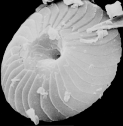Introduction to the Prymnesiophyta
Coccolithophorids and other Haptophytes
Also known as Haptophyta, the Prymnesiophyta includes about 500 living
species in 50 genera, with many additonal fossil genera and species, most notably the coccolithophorids.
Members of this group are primarily unicellular, and are photosynthetic.
They are often important sources of food for aquatic communities.
Prymnesiophyte algae are generally marine and are mostly tropical, though
there are a few freshwater and terrestrial species reported. The group occurs
worldwide, and several species have global distributions.
Some prymnesiophytes produce algal blooms which may cause serious
problems for fish and for fishermen. Large blooms are problematic because
of the mucilage surrounding the algal cells; it may clog fish gills, or render
them permeable to dissolved toxins. Another problem is the production of
dimethyl sulfide (DMS), a noxious-smelling compound which has been
known to cause fish migrations to alter their normal routes.
Haptophytes are often a golden-brown color because of the presence of the
yellow-brown accessory pigments,
diadinoxanthin and fucoxanthin, a feature they share with other
Chromista. These are contained in
the one or two plastids that are present in the cell. Prymnesiophytes may
have a complex life cycle, with an alternation between motile and non-
motile phases of different morphologies.
The name Haptophyta was originally applied to the group because of the
presence of the unique organelle, the haptonema. This is a peg-like
structure that extends out from the cell near the point where the two flagella
are attached. The haptonema was originally thought to be a third flagellum,
but has since been found to have a quite different morphology, and its
function is unknown.
 Many prymnesiophytes are covered with scales, which can have rather
complex architecture; they may have spines or an elaborated rim, and come
in an amazing variety of shapes -- pentagons, muffin-shapes, baskets,
donuts, or even trumpet-like shapes are known. The scales may remain
unmineralized, and consist primarily of carbohydrates, or they may be
calcified; silica plates are rare. These plates are formed by deposition within
the Golgi apparatus, and are often embedded in mucilage.
Many prymnesiophytes are covered with scales, which can have rather
complex architecture; they may have spines or an elaborated rim, and come
in an amazing variety of shapes -- pentagons, muffin-shapes, baskets,
donuts, or even trumpet-like shapes are known. The scales may remain
unmineralized, and consist primarily of carbohydrates, or they may be
calcified; silica plates are rare. These plates are formed by deposition within
the Golgi apparatus, and are often embedded in mucilage.
Coccolithophorids are the best known members of the Prymnesiophyta.
These delicate-looking organisms have external calcified plates (known as
coccoliths), with a complex ornamentation. Cells may bear only
one kind of plate or two. The plates accumulate on the bottom of the ocean
as the organisms die, and there contribute to the formation of ocean
sediments, carbonate oozes, and rocks such as the Mesozoic limestones and chalks.
Fossils of this group date back into the
Jurassic, where they first
become abundant, and some possible fossils of coccolithophores have been
recovered from the Pennsylvanian. The group made a sudden and rapid
appearance of new forms in the early Jurassic, and reached its greatest
abundance in the Late Cretaceous. Near the end of the Cretaceous, the
coccolithophores suffered a mass extinction of groups; two-thirds of the 50
genera disappear at that time, though many new groups appear in the Paleocene.
Extensive information on Emiliania huxleyi, a common marine coccolithophore,
is available from the Ehux Web Site, including SEM and satellite pictures.
Join the Nannofossil List Group!

Pictures of coccolith courtesy Dr. William Ruddiman and the US National
Geophysical Data Center.


 Many prymnesiophytes are covered with scales, which can have rather
complex architecture; they may have spines or an elaborated rim, and come
in an amazing variety of shapes -- pentagons, muffin-shapes, baskets,
donuts, or even trumpet-like shapes are known. The scales may remain
unmineralized, and consist primarily of carbohydrates, or they may be
calcified; silica plates are rare. These plates are formed by deposition within
the Golgi apparatus, and are often embedded in mucilage.
Many prymnesiophytes are covered with scales, which can have rather
complex architecture; they may have spines or an elaborated rim, and come
in an amazing variety of shapes -- pentagons, muffin-shapes, baskets,
donuts, or even trumpet-like shapes are known. The scales may remain
unmineralized, and consist primarily of carbohydrates, or they may be
calcified; silica plates are rare. These plates are formed by deposition within
the Golgi apparatus, and are often embedded in mucilage.


